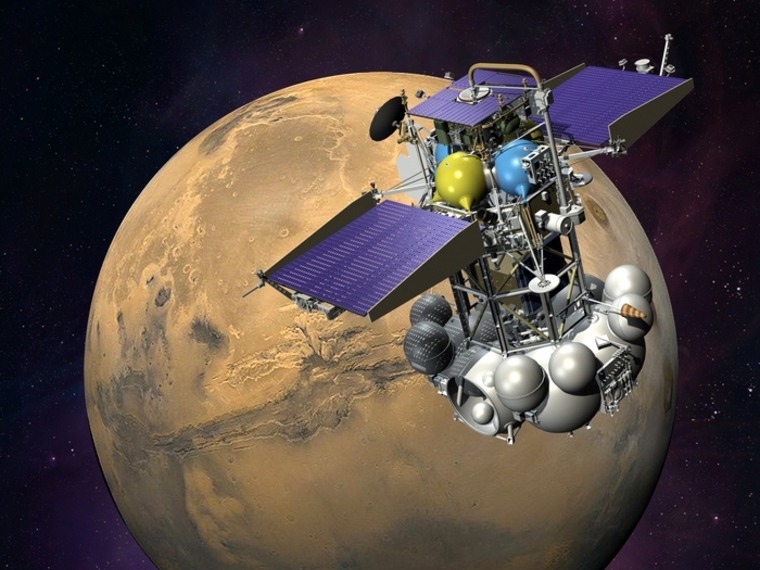The European Space Agency reported Wednesday that a ground station in Australia has made repeated contacts with Russia's Phobos-Grunt probe, two weeks after a mysterious post-launch glitch.
The reports sparked a growing glimmer of hope for a mission that seemed as good as dead a day earlier.
The $170 million Phobos-Grunt ("Phobos-Soil") mission was designed to land on Phobos, the larger of Mars' two moons, scoop up a soil sample and return it to Earth. The spacecraft is also carrying China's first interplanetary probe, Yinghuo 1, which is supposed to be dropped off in Martian orbit.
Before its Nov. 9 launch from the Baikonur Cosmodrome in Kazakhstan, the Phobos-Grunt mission was heralded as a sign of Russia's resurgence in interplanetary exploration. The 13-ton spacecraft reached Earth orbit, but it did not fire its engines as scheduled to start its months-long cruise toward the Red Planet.
Since then, Russian controllers have been struggling to contact the probe, aided by ESA as well as NASA. On Tuesday, the Interfax news agency quoted Russia's deputy space chief, Vitaly Davydov, as saying that "chances to accomplish the mission are very slim."
Then ESA said its tracking station in Perth, Australia, made contact with the probe late Tuesday (around 20:25 GMT, or 3:25 p.m. ET).
ESA explained on its website that the job was particularly challenging because it was hard to get a precise fix on the spacecraft for a narrow-beam transmission, and because Phobos-Grunt's antenna was optimized to receive low-power transmissions in deep space.
"In the past few days, ESA's 15 m-diameter Perth dish was modified by the addition of a 'feedhorn' antenna at the side of the main dish so as to transmit very low-power signals over a wide angle in the hopes of triggering a response from the satellite," the space agency said.
The response came in the form of a simple confirmation from the probe that it had executed commands to switch on its transmitter.
Second contact
Later Wednesday, ESA spokesman Rene Pischel reported that the Perth station received useful telemetry from Phobos-Grunt during a subsequent pass.
"We have again established contact with the Phobos-Grunt spacecraft, we obtained telemetry reports, they are being analyzed by our colleagues from the Lavochkin Research and Production Association," the RIA Novosti news service quoted Pischel as saying.
RIA Novosti said the contact lasted only six minutes, and more data would probably be required to diagnose Phobos-Grunt's problem. NPO Lavochkin, the probe's prime developer, has been in charge of making the diagnosis.
If the probe can be revived, NBC News space analyst James Oberg said it could rank as "the biggest 'space rescue' since Apollo 13, Skylab and the iceberg space station Salyut 7."
Now what?
It's not clear what options are still available for continuing Phobos-Grunt's mission. Some reports from Russia have suggested that the opportunity for a round trip to Phobos and back has already been lost. Davydov, however, said Russian engineers had until the end of the month to fix the probe's engines and send it on a path to Phobos.
Russian scientists could fix the problem if the probe failed because of a software flaw, but some experts think that the failure was rooted in hardware that's difficult to fix.
Even if Phobos-Grunt could no longer execute its sample return mission, it could still conceivably take on a one-way trip to Mars and its moon, or head for a different destination, such as Earth's moon or an asteroid. That assumes, of course, that Phobos-Grunt's onboard systems can be fully revived.
If the mission fails, that could affect Russia's priorities for space research. The Russian space agency would more likely focus on moon research instead of studying Mars, Davydov said.
Davydov said that if engineers can't take control of the spacecraft, it could crash to Earth sometime between late December and late February. The site of the crash cannot be established more than a day in advance, he said.
"If you calculate the probability of it hitting somebody on the head, it is close to zero," he said.
More about Mars:
- Why it's so hard to get to Mars
- NASA rover to look deep into Mars' past
- Greatest hits from the Red Planet
This report includes information from msnbc.com and The Associated Press.
